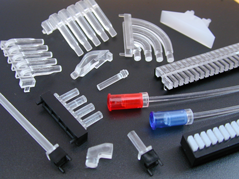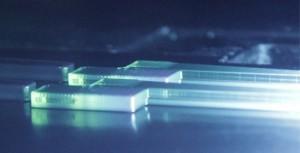 Look around your room when it’s dark. I’m willing to bet there’s more than one tiny, blinking light glowing in the darkness. From your computer, your phone, your TV – we all have constellations of tiny electronic stars reassuring us that our devices, our connections to the outside world, are nearby and working properly. These tiny indicator lights are actually LED light pipes. The little green light that you see on the outside of your computer is coming from a larger LED light further inside the device. That light is routed to the indicator through a long, thin plastic lens known as a light pipe. Their versatility means that computer designers can place indicator lights anywhere on the device while keeping the LED source light mounted to the central circuit board.
Look around your room when it’s dark. I’m willing to bet there’s more than one tiny, blinking light glowing in the darkness. From your computer, your phone, your TV – we all have constellations of tiny electronic stars reassuring us that our devices, our connections to the outside world, are nearby and working properly. These tiny indicator lights are actually LED light pipes. The little green light that you see on the outside of your computer is coming from a larger LED light further inside the device. That light is routed to the indicator through a long, thin plastic lens known as a light pipe. Their versatility means that computer designers can place indicator lights anywhere on the device while keeping the LED source light mounted to the central circuit board.
With the multitudes of complex parts required to build a computer, one may not think of the indicator light as one of the more difficult or complicated ones. They’re more challenging than you may think, however. The part must fit both the outer casing and the circuit board-mounted LED, and also needs to be shaped for optimal light performance. This may not sound difficult, but designers often must wait days or weeks for a milled part or a pattern for molding, and they don’t always get the ideal fit on the first try. Because of the costs involved in prototyping this tiny part, designers often go with the safest route, rather than the route that will allow for the best performance.
for molding, and they don’t always get the ideal fit on the first try. Because of the costs involved in prototyping this tiny part, designers often go with the safest route, rather than the route that will allow for the best performance.
CADD Edge, a certified reseller of Stratasys 3D printing equipment, wanted to help. Using Stratasys’ Objet 260 Connex 3D printer and VeroClear material, they printed several light pipes, with varied designs, in 35 minutes, for a cost of only a few dollars. The company then tested two different designs of a common 90-degree light pipe. One of them, with a curved bend, performed much more poorly than the other, which featured a 45-degree bend that provided optimum reflection. Choosing the better part was simple–and the entire process, from CAD to the testing stage, took about two hours. In traditional prototyping, a designer might test the curved pipe and decide that its performance is mediocre. The options then are to use it anyway, even though it doesn’t emit nearly as much light as hoped, or to order another design and wait several days before being able to test it. And if that one doesn’t work…well, you can see how the time and money begin to add up.
“With such a fast turnaround, the designer could test and choose the best of multiple designs (we printed four iterations at once), then even revise and print the same day,” said Marcus Weddle of CADD Edge. “This rapid iteration cycle allows for more design ideas, and a much higher confidence in the design going forward to the next prototyping stage. As a bonus, the time for these additional iterations is still far shorter than the traditional method.”
 It goes to show, then, that even the smallest and seemingly most inconsequential of electronic parts are critical to the design process, and can greatly affect the time and cost of building a device. 3D printing, as Stratasys has shown, can drastically cut both of those. Less expense involved in designing a computer means, ultimately, less expense involved in buying one, and you can rest assured that your constellations of LED lights will glow at their brightest while you sleep.
It goes to show, then, that even the smallest and seemingly most inconsequential of electronic parts are critical to the design process, and can greatly affect the time and cost of building a device. 3D printing, as Stratasys has shown, can drastically cut both of those. Less expense involved in designing a computer means, ultimately, less expense involved in buying one, and you can rest assured that your constellations of LED lights will glow at their brightest while you sleep.
What are your thoughts on the future of 3D printing and electronics? Let us know in the 3D Printing Electronics forum thread on 3DPB.com.
Subscribe to Our Email Newsletter
Stay up-to-date on all the latest news from the 3D printing industry and receive information and offers from third party vendors.
You May Also Like
Profiling a Construction 3D Printing Pioneer: US Army Corps of Engineers’ Megan Kreiger
The world of construction 3D printing is still so new that the true experts can probably be counted on two hands. Among them is Megan Kreiger, Portfolio Manager of Additive...
US Army Corps of Engineers Taps Lincoln Electric & Eaton for Largest 3D Printed US Civil Works Part
The Soo Locks sit on the US-Canadian border, enabling maritime travel between Lake Superior and Lake Huron, from which ships can reach the rest of the Great Lakes. Crafts carrying...
Construction 3D Printing CEO Reflects on Being Female in Construction
Natalie Wadley, CEO of ChangeMaker3D, could hear the words of her daughter sitting next to her resounding in her head. “Mum, MUM, you’ve won!” Wadley had just won the prestigious...
1Print to Commercialize 3D Printed Coastal Resilience Solutions
1Print, a company that specializes in deploying additive construction (AC) for infrastructure projects, has entered an agreement with the University of Miami (UM) to accelerate commercialization of the SEAHIVE shoreline...






























